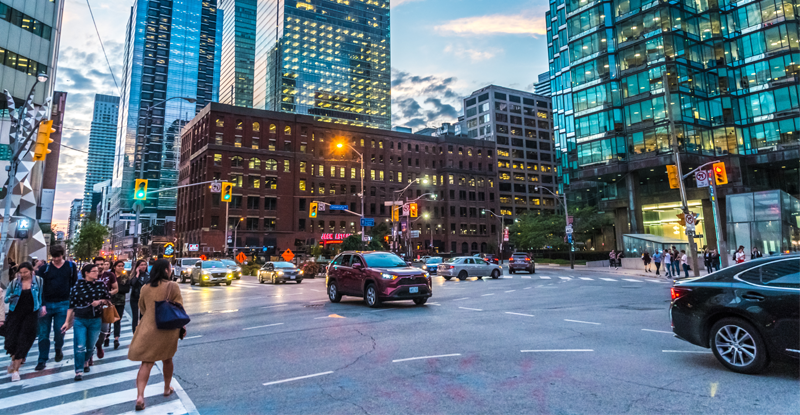Canada’s office vacancy rates still rising despite back to office push
 Just over 18 per cent of office space across Canada is vacant, with Vancouver and Toronto hovering around 12 and 16 per cent. Before the COVID-19 pandemic, they hovered around two per cent for several years. Photo: Adobe Stock
Just over 18 per cent of office space across Canada is vacant, with Vancouver and Toronto hovering around 12 and 16 per cent. Before the COVID-19 pandemic, they hovered around two per cent for several years. Photo: Adobe Stock
Municipalities and big businesses have been pushing more of their employees to return to the office. However, office vacancy rates have remained stubbornly high and continued to rise in Canada.
In the second quarter of 2023, just over 18 per cent of office space across the country was vacant, according to commercial real estate firm CBRE. A July report from the company said “Canadian office markets are grappling with a perfect storm” of challenges from high interest rates, tech sector weakness, and the rise of remote working.
In Metro Vancouver, the office vacancy rate is around 10 per cent. In Downtown Vancouver itself, the number was around 12 per cent. In downtown Toronto, CBRE found the vacancy rate was almost 16 per cent.
Those numbers might not seem very high, but when compared with pre-pandemic rates, the difference is stark. Before the COVID-19 pandemic, Canada claimed the two lowest-vacancy office markets in North America in Toronto and Vancouver, where downtown vacancy hovered around two per cent for several years.
Challenges in Filling Office Spaces
In Calgary, 31 per cent of offices in the downtown area were vacant in the second quarter of 2023. To tackle the problem, the city has created a Development Incentive Program for downtown Calgary. The program is designed to support property owners to redevelop or remove underused office space and bring a greater mix of amenities and services to the area.
The city has approved 10 projects that officials say will create over 1,400 new homes and remove roughly 1.37 million square feet of unused office space from the market.
“This is almost a third of our 10-year goal of removing six million square feet of office space from the downtown market,” said Neil Babaluk, communications planner for the City of Calgary’s Downtown Strategy. “We expect that the first of these projects will be available for rental and occupancy later this year.”
In Ottawa, more than 15 per cent of offices were vacant in the second quarter of 2023. That was up from 13.2 percent in the first three months of this year. The city faces unique challenges when it comes to filling office spaces.
Public Services and Procurement Canada (PSPC), the department that manages the federal government’s real estate, is the largest commercial tenant in Ottawa. However, that might be changing soon. In May, PSPC deputy minister Paul Thompson said the government is aiming to cut its office footprint by half. Thompson cited the pandemic and hybrid working models as the main reason for the cuts.
“Obviously we see an opportunity for a fairly significant reduction in the coming years,” Thompson told members of the Standing Committee on Government Operations and Expenditures in May. “Our previous target was to reduce the portfolio by 40 per cent. We now think we can reduce it closer to 50 per cent as a target.”
“The situation in Ottawa is uniquely different as the federal government influence in the core has always been a stable employment base. Following COVID, the work-from-home requirement during this time became very appealing to the public sector workforce,” said Christine Leadman, the executive director of Centretown, previously known as Bank Street BIA. “The results were less than ideal for the downtown core of the City of Ottawa in the scattered approach in the back-to-work directives.”
Collaborate to Stop Deterioration of City Cores
Another issue for some businesses is crime in downtown areas.
In July, Statistics Canada released data showing an uptick in violent crime. Crime rates have been coming down in recent decades and are still much lower than they were 25 years ago. However, repeated violence is causing some businesses to call it quits.
In July, coffee chain JJ Bean announced they would be closed their location in Downtown Vancouver’s Gastown area, citing increasing crime impacting the business. JJ Bean’s CEO, John Neate, said staff at the location were regularly having to deal with broken windows and harassment.
“Critical to improving the situation, there needs to be attention given to the main streets of major cities in relation to the on-street conditions that were exacerbated during COVID,” Leadman said. “The lack of mental health, supportive housing, and addiction services has been drastically underfunded for years. This issue needs the collective minds of all levels of government to aggressively address this issue to stop the deterioration of our cities’ cores.” MW
✯ Municipal World Executive and Essentials Plus Members: You might also be interested in Ibrahim’s other article: Municipal workers skeptical of returning to the office.
Ibrahim Daair is staff writer at Municipal World.
Related resource materials:



